by Philip Boxer
The following note summarizes the current state of development of the Libidinal Economy of Discourses (LEoD). It covers my initial formulation, the conditions under which I consider it to become a necessary praxis, the diagnostic tools I developed to support its use and the psychoanalytic thinking that provides its basis.
LEoD Origins
I first wrote about the LEoD in 1990 (Boxer and Kenny 1990). I was trying to make sense of resistance to change in organisations, which I later came to refer to as the conservation of identity (Boxer and Eigen 2004) and as a defence against innovation (Boxer 2014).
The LEoD was a way of describing the systemic characteristics of this conservation of identity. At that stage, the LEoD looked like this[1]:
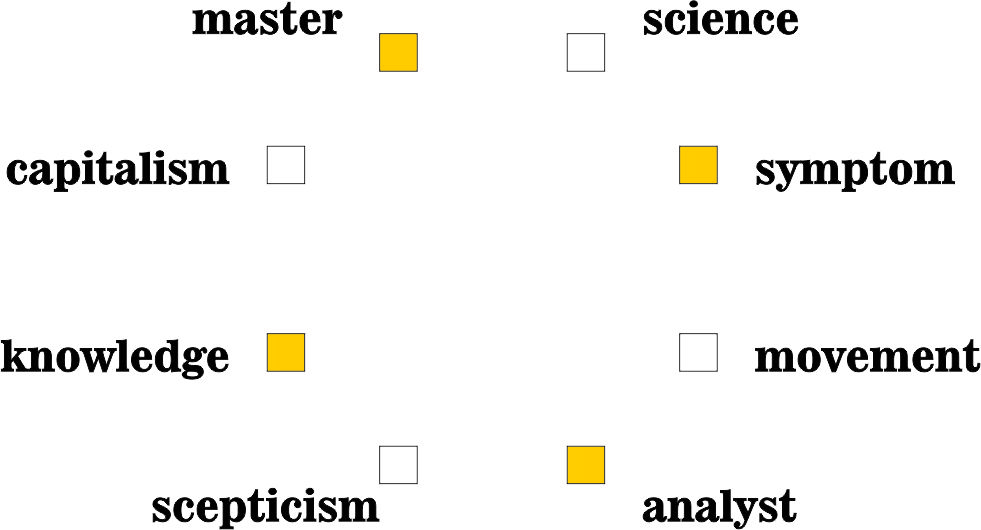
The eight discourses making up the LEoD were derived from two things:
- Two forms of Lacan’s Schema L (Lacan 2006c[1996])…
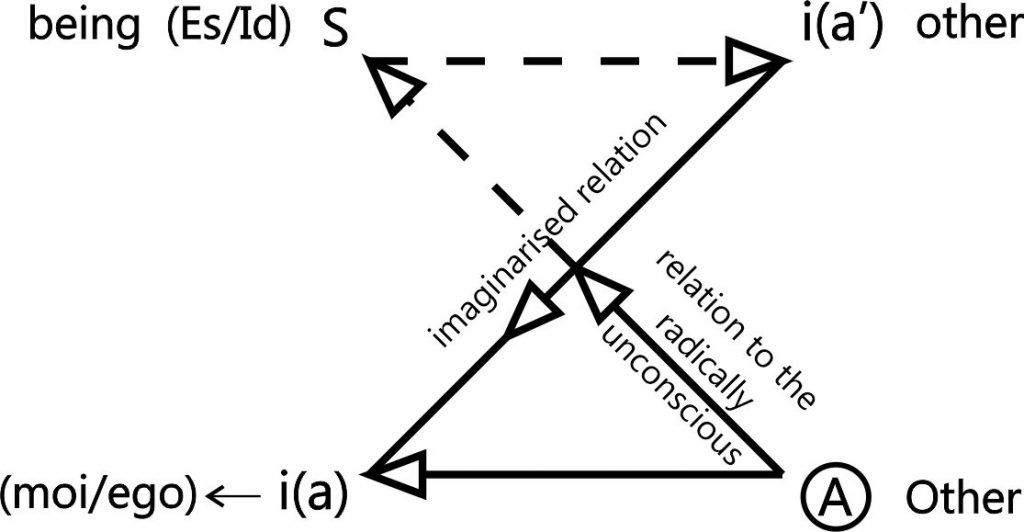
… in which particular existential commitments could be recognised in ways of being in relation to speaking-and-listening[2]:
“it is either me listening making sense of the other speaking; or the other speaking defining what sense can be made by me listening. They have a very different quality: the +ve discourse is active in the sense of someone making sense of the situation; whereas the -ve discourse is passive in the sense that the [social] situation is defining what sense can be made by someone.” (Boxer and Kenny 1990)

- Two ‘cuts’, first between a diachronic/syntagmatic structuring and a synchronic/paradigmatic structuring of speaking-and-listening; and second between a 10 domain of experience and a 20 domain of explanation. These two ‘cuts’ were combined to define the framing ontology of an observer (Boxer and Kenny 1990)[3]:
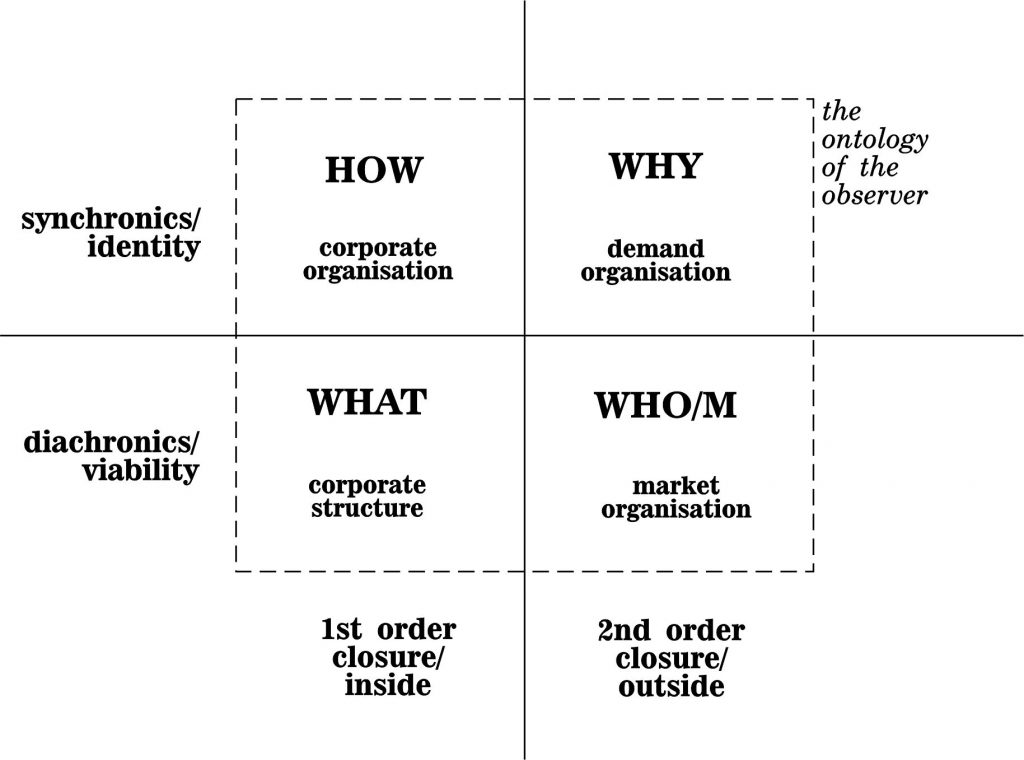
They defined the reality constituted by speakers-and-listeners.
The 8 forms of discourse then arose from the ways in which individuals’ existential commitments were supported by the framing ontology of the organisation in question[4].
The LEoD itself was then a way of describing how these discourses adopted stable configurations in relation to each other. This gave rise to the invariant characteristics of a corporate culture and its sub-cultures aka the way in which it conserved its identity:
What we have in mind is a 30 closure constitutive of a particular configuration of speaking/listening positions in relation to each other, the characteristic of which define the ‘culture’ we are working in – its tribal characteristics. If languaging is constitutive of the ontology of the observer, we wish discourse and its organisation in the form of an economy to be constitutive of the phylogeny of the observer. (Boxer and Kenny 1990)
This stable configuration arose because of the relations between any one active/positive discourse and the other 4 passive/negative discourses, in the figure below the discourse of the master:
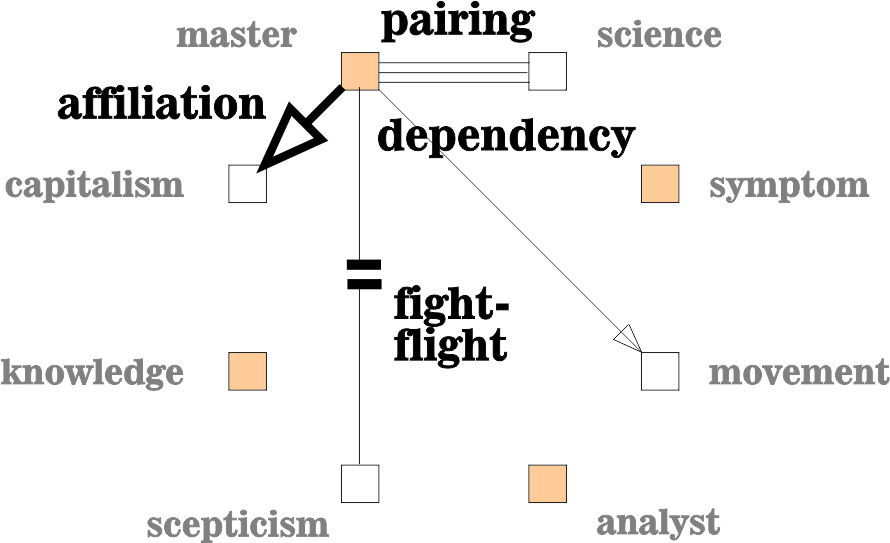
Affiliation (formerly Dependency[5]): ‘who you are is defined by how things are organised’; Dependency (formerly Master-Slave[5]): ‘this is how you should speak to others to be like us’; Pairing: ‘you must tell me what the reasons are for what is happening’; and Fight-Flight: ‘what I say doesn’t make sense to you. You can’t make what I claim to know work in practice’ (Boxer and Kenny 1990).[6]
Two case examples were then given in which the economy was used to give an account of the ways in which the organisations had become ‘stuck’ (Boxer and Kenny 1990):
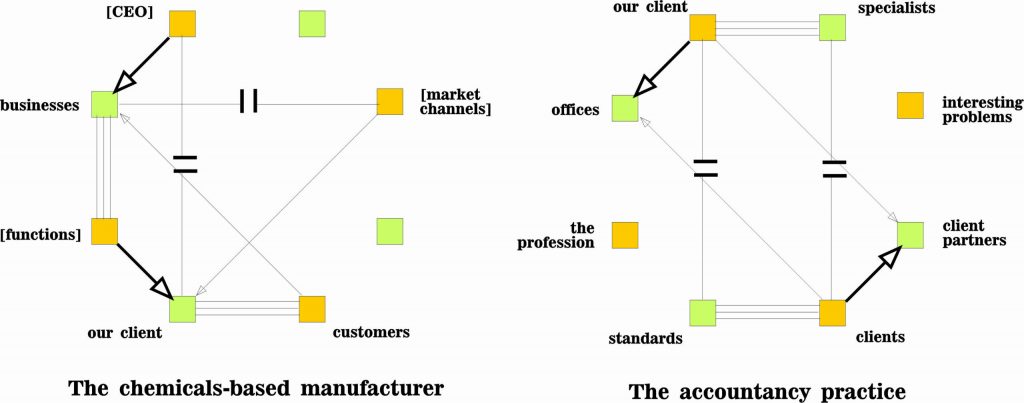
No further elaboration was made of the four types of relation between an active/positive discourse and the other four passive/negative discourses. The impression left by the paper was of the LEoD as an intuited ‘truth’ with explanatory power, as a useful way of hypothesizing the form taken by a 30 closure, but nevertheless a hypothesis that lacked an adequate underpinning explanation for why it should take this form. At that time it stood as a first step in addressing the limitations of systemic thinking and radical constructivism (Boxer and Kenny 1992).
It has taken a long time to make sense of that original intuition! I have persisted because it seems to me that we still lack an adequate understanding of resistance-to-change aka ‘conservation of identity’ and the forms of maladaptation that they give rise to. What is perhaps more evident than ever are the consequences of maladaptation both for the environment (the impact of externalisation of costs cumulatively on the climate) and for our fellow citizens (growing inequalities induced by winner-take-all ideologies).
Who should be caring about maladaptation?
Resistance, or conservation of identity, is about the way individuals use organisations through the way an organisation supports their preferred ways of ignoring (Boxer 1999), ‘strategy’ being about managing what is to be ignored in the interests of sustaining competitive advantage (Boxer and Eigen 2005, Boxer 2014). At issue here is the level at which the strategy ceiling of an organisation can afford to remain set, given the requirement for sustainability and the nature of the competitive environment (Boxer and Eigen 2004). The maladaptation arises if the ceiling cannot be lifted as needed to maintain the necessary balance (Baburoglu 1988).
Maladaptation shows itself as dogmatism, splitting and stalemate, the latter arising from privileging a focus on process above any focus on outcomes. It places the continued existence of the organisation in jeopardy. The effects of maladaptation become most apparent under turbulent competitive conditions, which demand that the organisation becomes edge-driven (Boxer 2019).
An existing corporate culture can be impervious to such challenges, however subtle and sophisticated the analysis of the competitive environment and the imperatives it imposes for an organisation’s survival. It is as if the sole function of an organisation is to support the identities of its managers and stakeholders – ‘going out of business on budget’ as one manager put it. This is not simply a matter of finding the right leader to exercise appropriate forms of top-down power. The resistance is systemic, rooted in all the small details that maintain the cohesion of an organisation’s behaviors, each one of which contributes in some way towards existing ways of using the organisation to support identifications (Boxer 2017b). Maladaptation nevertheless has severe consequences in the lives of the clients of maladaptive organisations (Boxer 2015, Boxer 2017a).
‘Culture’ in these terms is thought of as a 3rd-order behavioural closure described by the LEoD, the maladaptive response assuming that culture must take the form of a unipolar top-down exercise of sovereignty. Becoming edge-driven challenges this, requiring the surrender of sovereignty to the interests of citizen-clients and a circulation of discourses. The LEoD provides a way of understanding how such a circulation can be enabled.
The entry-point, then, to this way of thinking about an organisation is in terms of 8 dimensions of leadership, each with its associated impact on the capabilities of the organisation:
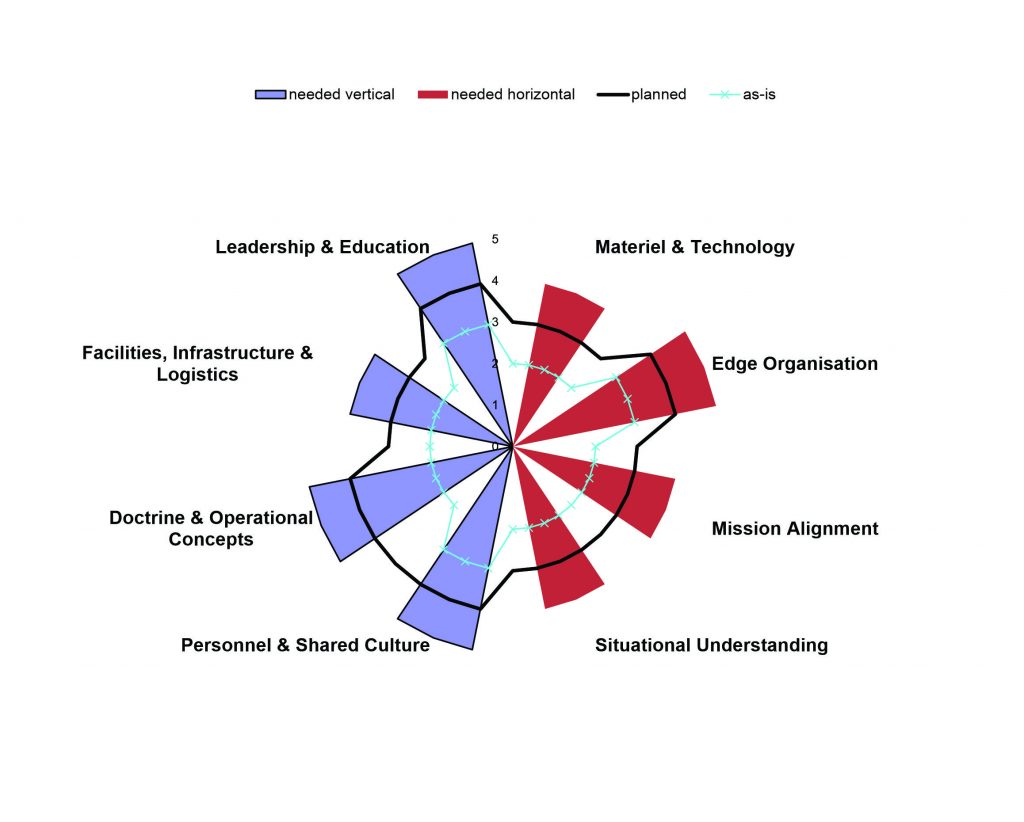
Given an existing imbalance between these 8 dimensions, the LEoD then becomes a way of diagnosing how this imbalance is sustained and therefore how it might be changed. Unpacking the implications of all this can be done in terms of 9 challenges.
The challenges to understanding maladaptation
1: What is the difference between a one-sided and a multi-sided relation to demand and how does this change our understanding of the economy (Pathway 1)? [7]
2: How does this impact on the capabilities demanded of an organisation and what might constitute ‘strategic’ behavior (Pathway 2)?
3: What does this require of an organisation’s structures of governance and the supporting platform architectures[8] (Pathway 3)?
4: How does this impact on the way individuals take up identifications in their ‘use’ of organisations (Pathway 4)?
5: Why distinguish active from passive identifications, in what sense is an organisation ‘used’ to support identifications, and how does this become apparent in the relations between individuals (Pathway 5)?
6: How is the 3+1 structuration of how we use language distinguished from the way we take up our relation to the unconscious and to desire (Pathway 6)?
7: How does this change the way we need to think about ‘systems’? (Pathway 7)
8: What is the relation to the radically unconscious that gives rise to the 3+1 structuration[9] and what understanding of this relation makes sense of this (Pathway 8)?
9: How does all this change how we understand our relation to identification (Pathway 9)?
Notes
[1] The name used by Lacan for ‘symptom’ was the discourse of the Hysteric and for ‘knowledge’ it was the discourse of the University. Lacan’s naming of ‘scepticism’ is not so clear, being referred to as the discourse of masquerade or of politics in Lacan, J. (1990). Television: A Challenge to the Psychoanalytic Establishment. London, W.W. Norton & Company. In Television, Lacan referred to the discourse of the movement as a ‘professional insurance plan against analytic discourse’ (PIPAAD); in French it was Societe d’assurance mutuelle contre le discours analytique (SAMCDA). Given the tendency of his followers towards the perverse form of the analytic discourse, it is no surprise that Lacan dissolved his followers’ movements!
[2] This was an early attempt at providing a gloss for the effects of the “little inversion” in the relation between agent and truth that is described by Lacan for the discourse of Capitalism in Lacan, J. (1978). Discourse of Jacques Lacan at the University of Milan on May 12 1972. Lacan in Italy. Milan, La Salmandra: 32-55. This inversion is what gives rise to the 4 passive/negative discourses. In the Lacanian literature we only hear the discourses of science and of capitalism spoken about. The structural understanding of the perverse forms is needed to identify the other two of the movement and of politics/masquerade.
[3] The axes have been transposed to align this diagram with later versions of it. The ‘cut’ between the diachronic/syntagmatic and the synchronic/ paradigmatic becomes the Cartesian ‘cut’ in later writing, the synchronic/paradigmatic being identified with the sense-making of consciousness. The ‘cut’ between 10 and 20 behavioural closures becomes the Heisenberg ‘cut’ once the behavioural closure is understood to be that of the client with whom the 10 closure is entangled; and the ‘cut’ implicit in the observer’s assertion of an ontology becomes the endo-exo ‘cut’ (endogenous-exogenous) once the observer is understood as embodied and therefore committed to their ontology, not just involved (speaking of eating breakfast, pigs are committed, while chickens are just involved!).
[4] The greatest difficulty arose here because of the need to explain the independent existence and invariance of the two 3+1 structures of ‘S1, S2, $ and a’ and ‘agent, object, truth and production’ with respect to each other. later work established Peirce, with his firstness, secondness, thirdness and relation-to-doubt, as a way of disambiguating the social forms of S1, S2, $ and a in Lacan’s use of these terms in this context. This left agent, object, truth and production as a uniquely Lacanian reading of the relation to drive structuration. To distinguish the two 3+1 structures, the Peircean and Lacanian quadripods had first to be distinguished and then their mutual dependence established on the subject’s 3+1 relation to a radically unconscious represented in the form of the RSI borromean knotting.
[5] In the original, what is here signified by ‘dependency’ was referred to as a master-slave relation, the use of affiliation releasing the former ‘dependency’ signifier.
[6] The switch in naming came with a deepening of these meanings based on an understanding of their structural nature. They also provide a way of bringing in the ‘basic assumption’ characteristics of the relations between the discourses following Bion (Experiences in Groups. 1959, London: Tavistock Publications) and Bain and Gould (1996, “The Fifth Basic Assumption.” Free Associations 6(1): 28-55). Hence the current form of these relationships:
- Affiliation – baA or baOneness – you try to make my truth your agent. You try to align yourself with me by taking my truths literally.
- Dependency – baD relation – you try to make my production become your truth. You try to follow what I do and not what I say.
- Pairing – baP – you make a truth of my production. You try to repeat the parts of being me that I am impotent to reach for myself.
- Fight-Flight – baF relation – your production comes in the place of my truth. You just do your own thing and don’t really listen.
[7] The first six of these challenges raise the need for requisite agility as being necessary to becoming edge-driven.
[8] The triple articulation of the relation to lack applies as much to these underlying architectures as it does to the 3+1 structuration in challenge 8. The current work on octonions promises to offer a possible way of thinking about the nature of the reasoning that is possible across these 3+1 structures.
[9] This is where a quantum theoretic understanding of the quantity/quality distinction in the neural networks becomes necessary, an understanding based on Zurek’s einselection – see Zurek, W. H. (2002). “Decoherence, Einselection, and the Quantum Origins of the Classical.” Quantum Physics.
References
Baburoglu, O. N. (1988). “The Vortical Environment: The Fifth in the Emery-Trist Levels of Organizational Environments.” Human Relations 41(3): 181-210.
Boxer, P. J. (1999). “The dilemmas of ignorance.” in What is a Group? A fresh look at theory in practice. C. Oakley. London, Rebus Press: 147-168.
Boxer, P. J. (2014). “Defences against innovation: the conservation of vagueness.” in Defences Against Anxiety: Explorations in a Paradigm. D. Armstrong and M. Rustin. London, Karnac: 70-87.
Boxer, P. J. (2015). “Betraying the citizen: social defences against innovation.” Organisational & Social Dynamics 15(1): 1-19.
Boxer, P. J. (2017a). “Caring Beyond Reason: A question of ethics.” Socioanalysis 19(December): 34-50.
Boxer, P. J. (2017b). “Working with defences against innovation: the forensic challenge.” Organizational and Social Dynamics 17(1): 89-110.
Boxer, P. J. (2020). “Vive la différence: when a choice is not about choosing.” Socioanalysis 22: 1-27.
Boxer, P. J. and C. A. Eigen (2004). Reflexive Consultation: supporting a CEO’s leadership of transformational change. OPUS Annual Conference. London.
Boxer, P. J. and C. A. Eigen (2005). Taking power to the edge of the organisation: re-forming role as praxis. Annual Meeting of the ISPSO. Baltimore, Maryland.
Boxer, P. J. and J. V. Kenny (1990). “The economy of discourses: a third order cybernetics?” Human Systems Management 9(4): 205-224.
Boxer, P. J. and J. V. Kenny (1992). “Lacan and Maturana: Constructivist Origins for a 3rd order Cybernetics.” Communication and Cognition 25(1): 73-100.
Lacan, J. (1978). Discourse of Jacques Lacan at the University of Milan on May 12 1972. Lacan in Italy. Milan, La Salmandra: 32-55.
Lacan, J. (1990). Television: A Challenge to the Psychoanalytic Establishment. London, W.W. Norton & Company.
Lacan, J. (2006c[1996]). Seminar on “The Purloined Letter”. Jacques Lacan Écrits: The First Complete Edition in English. J.-A. Miller. New York, W.W. Norton & Co: 6-48.
Zurek, W. H. (2002). “Decoherence, Einselection, and the Quantum Origins of the Classical.” Quantum Physics.